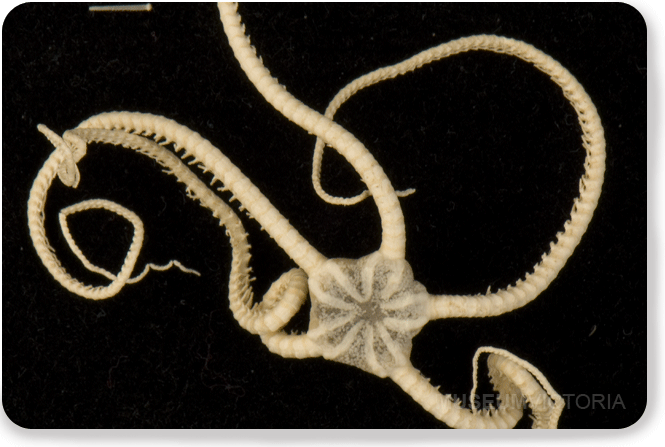
Home -> Species index -> Species description
 More images | Distribution map More images | Distribution map | F 93075, 93057. Family - Asteronychidae. |
Description The disc is flat, 13 mm diameter. The radial shields are narrow, straight-sided, separated and parallel to one another or contiguous proximally, divergent distally, with 3–6 plates between them; 3–6 times long as wide, and length 0.4 times d.d. The dorsal surface is covered by plates, no spines/granules, obscured by skin, with a visible diameter of 0.2–0.55 mm, overlapping or touching or seperated; primary plates not visible. The ventral interradial surface is with skin-covered plates. The oral shields are covered in skin. The adoral shields are covered in skin. Bursal slits reduced, not bordered by spines or papillae. The jaw is as wide as long, with one, pointed or tapering apical papilla, as wide as long. Oral papillae absent. The oral tentacle pore is located out of the jaw on top of the ventral disc, with no scales. The specimen has five arms, unbranched, moniliform, 5–8 times d.d. Dorsal arm plates not visible, covered by skin, without spines/granules. The second ventral arm plates are not visible. Ventral arm plates of the first free segments not visible, covered. Tentacle pores along the arm, with no scales. There are 0 arm spines on the first ventral segment, 2 on the first free segments. The spines are erect, restriced to the ventral surface, longest ventrally, and 0.5–2 times as long as one arm segment, blunt, cylindrical or flattened. There are thorns, hapazardly on the spine surface, all along the spine, glassy rough shaft. Spines also ventral spine specialised (elongated compared to dorsal spine and often with enlarged spherical thorny tip).
Description exported from Delta key and to be finalised when DNA sampling completed. Note species description and image characters may vary slightly in animals of different size within the same species. Cite this publication as: "T O'Hara
(2010). ‘Ophiuroids from deep sea southern Australia. Museum Victoria. Version:
1.0 http://www.museumvictoria.com.au/stars" MUSEUMVICTORIA |